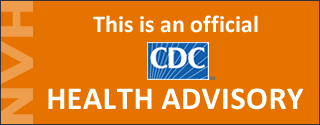Guidance for Clinicians Caring for Individuals Recently Evacuated from Afghanistan
Distributed via the CDC Health Alert Network
September 20, 2021, 3:45 PM ET
CDCHAN-00452
Summary
The Centers for Disease Control and Prevention (CDC) recommends that clinicians be on alert for cases of measles that meet the case definition, as well as other infectious diseases, including mumps, leishmaniasis, and malaria, among evacuees (including both Afghan nationals and U.S. citizens) from Afghanistan. Clinicians should immediately notify their local or state health department of any suspected cases of measles. Clinicians should also recommend the measles, mumps, and rubella (MMR) vaccine for unvaccinated patients. Measles is an extremely contagious infectious disease; around 9 out of 10 people who are close contacts and who are not protected will become infected following exposure to measles virus. As of September 20, 2021, CDC has been notified of 16 confirmed cases of measles and 4 cases of mumps among Afghan nationals and U.S. citizens, recently arriving from Afghanistan and continued vigilance is needed. In addition to MMR vaccination, CDC recommends that evacuees are also up to date on vaccinations for varicella, polio, COVID-19, and seasonal influenza.
Background
The U.S. government is in the process of resettling U.S. citizens and Afghan nationals from Afghanistan. Approximately 124,000 people, including about 6,000 American citizens, have been safely flown out of Afghanistan. Many of the evacuees are from areas with limited access to healthcare and vaccinations and have been living in close quarters for long periods during the evacuation process, thereby raising the risk of disease spread.
As of September 20, 2021, CDC has been notified by public health departments of 16 measles cases among the evacuees. All patients confirmed to have measles have been isolated and provided care, and their contacts have been quarantined. Contacts who were not immune were given the MMR vaccine or, if not vaccine-eligible, immunoglobulin. Evacuees who are in the United States are required to be vaccinated with MMR and complete a 21-day quarantine from the time of vaccination at U.S. “Safe Haven” designated locations, such as military bases1. Some evacuees left bases before measles cases were identified and a mass vaccination campaign began. In addition, some evacuees who arrived in the United States early in the repatriation and resettlement process were transported to locations other than the current eight bases for temporary housing.
Evacuation flights from Safe Havens in other countries to the United States have been temporarily halted at CDC’s request to facilitate MMR administration and post-vaccine quarantine efforts. During this halt, CDC has requested that all unvaccinated individuals awaiting evacuation be vaccinated for measles and quarantined for 21 days before leaving for the United States.
CDC expects the possibility of additional measles infections and spread among evacuees, based on ongoing transmission and low vaccine coverage (approximately 60%) in Afghanistan, and close living quarters during the process of evacuating people to the United States. Public health officials should continue to look for people with communicable disease symptoms, isolate those with symptoms, and track contacts to manage the spread of the illness, reporting to CDC as consistent with National Notifiable Diseases Surveillance System (NNDSS) requirements. CDC is also working with partners to identify infections at their onset and limit their spread.
In addition to the recognized concerns about vaccine-preventable diseases, evacuees are at increased likelihood of gastrointestinal infections, including shigellosis, giardiasis, cryptosporidiosis, hepatitis A, rotavirus, and viral diarrheal diseases. CDC is also aware of some cases of varicella, mumps, tuberculosis, malaria, leishmaniasis, hepatitis A, and COVID-19 among evacuees. Although COVID incidence in this population has been notably low, COVID immunization and testing is being provided for all evacuees. Environmental and personal hygiene, elimination of crowding, wearing masks, and safe food and water supplies will address most of these; however, individuals supporting this effort should ideally be vaccinated against hepatitis A, in addition to being current on routine U.S. immunizations.
As always, clinicians should be cognizant of the possibility of infections among patients arriving in or returning to the United States from other countries. Collecting a detailed travel history, particularly when signs and/or symptoms of gastrointestinal infections as mentioned above, mumps, varicella, tuberculosis, malaria, leishmaniasis, hepatitis A, and COVID-19 are present, may help in identifying and taking appropriate action to prevent further spread of these diseases within the United States.
1Marine Corps Base Quantico, Virginia; Fort Pickett, Virginia; Fort Lee, Virginia; Holloman Air Force Base, New Mexico; Fort McCoy, Wisconsin; Fort Bliss, Texas; Joint Base McGuire-Dix-Lakehurst, New Jersey; and Camp Atterbury, Indiana.
Infection-specific Recommendations
Measles
Afghanistan ranks seventh in the world for measles cases. People with measles can spread the virus to others from four days before through four days after the rash appears. Measles virus can remain infectious for up to two hours in an airspace after an infected person leaves an area and can be spread to large numbers of susceptible people very rapidly. Measles outbreaks in refugee camps and other congregate settings lead to high morbidity and mortality (as high as 34%). In 2000, measles was declared eliminated from the United States, meaning the disease is no longer endemic in this country. However, travelers continue to bring measles into the United States, and community transmission in connection with these travel-associated cases poses an ongoing risk to unvaccinated persons and thereby measles elimination.
CDC advises clinicians across the United States to maintain vigilance for cases of measles that meet the case definition. Vigilance should be particularly enhanced in communities near the military bases that are housing the evacuees: Marine Corps Base Quantico, Virginia; Fort Pickett, Virginia; Fort Lee, Virginia; Holloman Air Force Base, New Mexico; Fort McCoy, Wisconsin; Fort Bliss, Texas; Joint Base McGuire-Dix-Lakehurst, New Jersey; and Camp Atterbury, Indiana. Acute measles illness is characterized by the following:
- Generalized, maculopapular rash lasting ≥3 days; and
- Temperature ≥101°F or 38.3°C; and
- Cough, coryza, or conjunctivitis.
Clinicians should immediately notify their local or state health department about any suspected cases of measles. State health departments should report measles cases promptly (within 24 hours) to CDC, directly to the domestic measles team at CDC’s National Center for Immunization and Respiratory Diseases by telephone (404-639-6247) or by email (measlesreport@cdc.gov) or to the CDC Emergency Operations Center by telephone (770-488-7100).
Clinicians should also recommend the MMR vaccine for unvaccinated patients. Live vaccines administered to a pregnant woman pose a theoretical risk to the fetus; therefore, live, attenuated virus and live bacterial vaccines generally are contraindicated during pregnancy. Persons who are at risk of severe disease and/or complications from measles should receive immunoglobulin (IG).
- Administer intramuscular immunoglobulin (IMIG) to evacuees <6 months of age.
- Administer intravenous immunoglobulin (IVIG) to immunocompromised evacuees.
- Conduct serologic testing (IgG) of pregnant women and administer IVIG if they test negative.
Any transport of suspected measles patients to healthcare settings must be preceded by notification of the receiving facility and the transport staff, e.g., EMS, of the patient’s suspected diagnosis.
Leishmaniasis
CDC advises clinicians to look for cases of leishmaniasis in Afghan evacuees. Cutaneous leishmaniasis is characterized by lesions on the skin that can change in size and appearance over time. The sores may start out as papules or nodules and evolve into ulcers. Visceral leishmaniasis is a more severe form of infection that requires urgent management. The signs and symptoms of visceral leishmaniasis include:
- Fever
- Weight loss
- Enlargement of the spleen and liver
Malaria
Because of the risk of malaria in individuals arriving in or returning to the United States from Afghanistan Afghan evacuees, CDC advises clinicians to also be vigilant for cases of malaria. The first symptoms of malaria (most often fever, chills, sweats, headaches, muscle pains, nausea, and vomiting) are usually not specific and are also found in other diseases (such as influenza and common viral infections). Fever in a person who has recently traveled in a malaria-endemic area should always be immediately evaluated with a thick and thin blood smear to look for parasites, or if results are not available within hours, a rapid diagnostic test while the blood smear results are pending. When diagnosed, malaria must be treated immediately to prevent poor outcomes and death. Severe malaria requires treatment with intravenous artesunate available through CDC.
Malaria is endemic to Afghanistan, and transmission occurs April through December in nearly half the country where altitudes are below 2,000-2,500 meters. The type of malaria in Afghanistan is 95% Plasmodium vivax, the type of malaria that can relapse if not treated appropriately, and 5% Plasmodium falciparum, the type of malaria most likely to cause severe disease.
Malaria was eliminated from the United States in the early 1950s; however, the vector that transmits malaria, the Anopheles mosquito, is present across the country. Travelers continue to bring malaria into the country, and numbers of cases have risen since the 1970s to about 2,000 cases per year. The last confirmed outbreak of locally transmitted malaria in the United States was in 2003.
Clinicians who need guidance on diagnosing, managing, and treating malaria cases, and access to intravenous artesunate can call the CDC Malaria Hotline Monday–Friday 9:00 am–5:00 pm ET at 770-488-7788, or afterhours at 770-488-7100. Clinicians should immediately notify their local or state health department about any confirmed case of malaria.
Polio
Afghanistan is one of two countries in the world where wild poliovirus remains endemic. Polio is a viral disease that is transmitted person to person and can cause serious symptoms that affect the brain and spinal cord. A small percentage of people with polio infection can develop more severe symptoms, including paresthesia (feeling of pins and needles), meningitis, and paralysis. About one in four people infected with poliovirus will develop symptoms that may include: sore throat, fever, fatigue, nausea, headache, and stomach pain. Since 1979, there have been no cases of polio originating in the United States, but, occasionally, a travel-related case has occurred, the last in 1993. While the risk is low, CDC advises clinicians to maintain vigilance for cases of polio in patients who have recently arrived from Afghanistan or in people who have had close contact with recent arrivals from Afghanistan and whose vaccination status is unknown.
Clinicians should immediately notify their local or state health department about any suspected case of polio and recommend polio vaccination for unvaccinated patients.
For More Information
Measles case definition
Information about measles
Information on MMR vaccines
Information on mumps
Information about leishmaniasis
Information on malaria
Malaria hotline
Information on polio
The Centers for Disease Control and Prevention (CDC) protects people’s health and safety by preventing and controlling diseases and injuries; enhances health decisions by providing credible information on critical health issues; and promotes healthy living through strong partnerships with local, national and international organizations.
Department of Health and Human Services
HAN Message Types
- Health Alert: Conveys the highest level of importance about a public health incident.
- Health Advisory: Provides important information about a public health incident.
- Health Update: Provides updated information about a public health incident.
###
This message was distributed to state and local health officers, state and local epidemiologists, state and local laboratory directors, public information officers, HAN coordinators, and clinician organizations.
###

